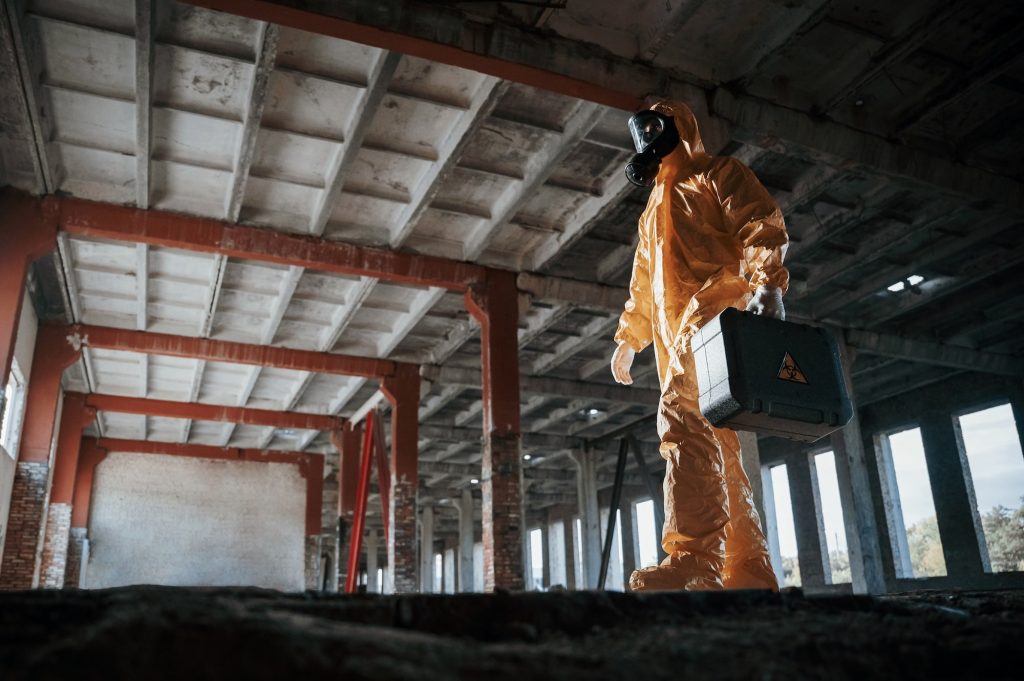If your property was built before the 1990s, there’s a chance it contains asbestos: a once-popular building material now known to pose serious health risks. Whether you’re renovating or responding to storm damage, it’s crucial to understand what asbestos abatement is and why it matters.
What Is Asbestos?
Asbestos is a naturally occurring silicate mineral made up of tiny, flexible fibers. It’s resistant to heat, electricity, and chemical corrosion. These qualities that once made it a go-to material in construction, insulation, and fireproofing.
There are six main types of asbestos, including chrysotile (the most common), amosite, and crocidolite. Despite differences in form, all types can become dangerous when disturbed and inhaled.
Why Was Asbestos Used?
Before its health risks were fully understood, asbestos was widely used in both residential and commercial buildings, especially during the mid-20th century. It showed up in products like insulation, drywall, floor tiles, roofing materials, cement, and even textured paints.
Contractors valued asbestos for its durability and fire resistance. Unfortunately, once those fibers become airborne, they’re not just tough — they’re toxic.
H2: What Is Asbestos Abatement?
Asbestos abatement is the process of safely removing or sealing asbestos-containing materials to prevent harmful exposure. It’s often necessary during remodeling, demolition, or after structural damage: any time materials might be disturbed and release asbestos fibers into the air.
Abatement doesn’t always mean removal. In some cases, encapsulation — sealing asbestos in place with a protective barrier — is a safer, more cost-effective option. The goal is always the same: reduce exposure risk and bring the building back to a safe condition.
Who Should Conduct Asbestos Abatement?
Asbestos abatement should never be a DIY project. In Colorado, only licensed asbestos abatement contractors are legally permitted to handle, remove, or dispose of asbestos materials.
Trained professionals follow strict safety protocols — including containment, air filtration, and proper disposal — to protect both occupants and the environment. Working with a certified team also ensures you meet all state and federal regulations.
The Asbestos Abatement Process
While the abatement process may vary somewhat from company to company, we’ll use our own process at Mile High Environmental Services to model how asbestos is tackled.
1. Estimation
When you contact MHES, our professional team will reach out with an estimate for your project, establishing scope and the project timeline.
2. Plan Development
Once we have confirmed the condition of the ACMs, their location, and the risk level associated with them, we will develop a comprehensive plan to securely remove the asbestos while eliminating hazards.
3. Containment
Before beginning any work, we will seal off the area in order to ensure that it is completely contained. Methods like plastic sheeting and negative air pressure systems will be used to guarantee that asbestos fibers won’t spread further in your property.
4. Removal & Disposal
Our certified technicians will thoroughly remove the identified ACMs with the utmost care and professionalism. Your project will be completed in a timely manner that prioritizes safety for all occupants and workers. We will also dispose of the ACMs removed.
5. Clearance Testing & Decontamination
Once the asbestos abatement has been completed, we will conduct clearance testing to ensure that all asbestos contamination risks have been eliminated. Then we will decontaminate and clear the area for public usage.
Frequently Asked Questions About Asbestos
Is asbestos always dangerous?
Asbestos is most dangerous when it’s disturbed and fibers become airborne. If materials containing asbestos are intact and undamaged, they may not pose an immediate risk — but should still be monitored.
Can I test for asbestos myself?
DIY test kits exist, but for accurate results and proper risk assessment, it’s best to hire a certified asbestos inspector or contractor.
Is asbestos still used in construction?
While most uses have been banned in the U.S., asbestos can still be found in some imported products. It’s also still present in many older buildings.
How long does asbestos abatement take?
Depending on the scope, abatement can take anywhere from a day to several weeks. A licensed contractor can provide a timeline after inspection.
Is abatement covered by insurance?
It depends on your policy and the reason for abatement (e.g., sudden damage vs. routine renovation). It’s best to check with your provider.
Get In Touch For Asbestos Abatement Services Today
If you suspect asbestos in your home or commercial property — or if you’re planning renovations in an older building — don’t wait. Exposure risks are serious, and professional abatement is the only safe solution.
Contact our Colorado-based team today for a consultation. We’re fully certified, locally trusted, and ready to help you create a safer space.


